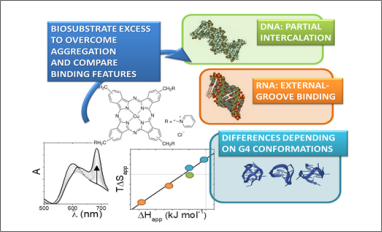 We present the analysis of the binding mechanism of a copper phthalocyanine (Alcian Blue-tetrakis(methylpyridinium) chloride, ABTP) to natural calf thymus DNA, G-quadruplexes and synthetic RNA polynucleotides in the form of double (poly(A)·poly(U)) or triple strands (poly(A)·2poly(U)). We show that apparent binding parameters can be calculated, which provide information on the binding mechanisms.
We present the analysis of the binding mechanism of a copper phthalocyanine (Alcian Blue-tetrakis(methylpyridinium) chloride, ABTP) to natural calf thymus DNA, G-quadruplexes and synthetic RNA polynucleotides in the form of double (poly(A)·poly(U)) or triple strands (poly(A)·2poly(U)). We show that apparent binding parameters can be calculated, which provide information on the binding mechanisms.
Absorbance titrations in the presence of biosubstrate excess, melting and circular dichroism experiments show that ABTP binds to both RNAs (external/groove binding) and DNA (intercalation). ABTP externally binds to both hybrid, parallel and anti-parallel G4s but seems to show a preference for anti-parallel structures. The thermodynamic features of the different systems are also discussed in the frame of the enthalpy-entropy compensation phenomenon.
The work is available at the following link: https://doi.org/10.1016/j.jinorgbio.2020.111199


